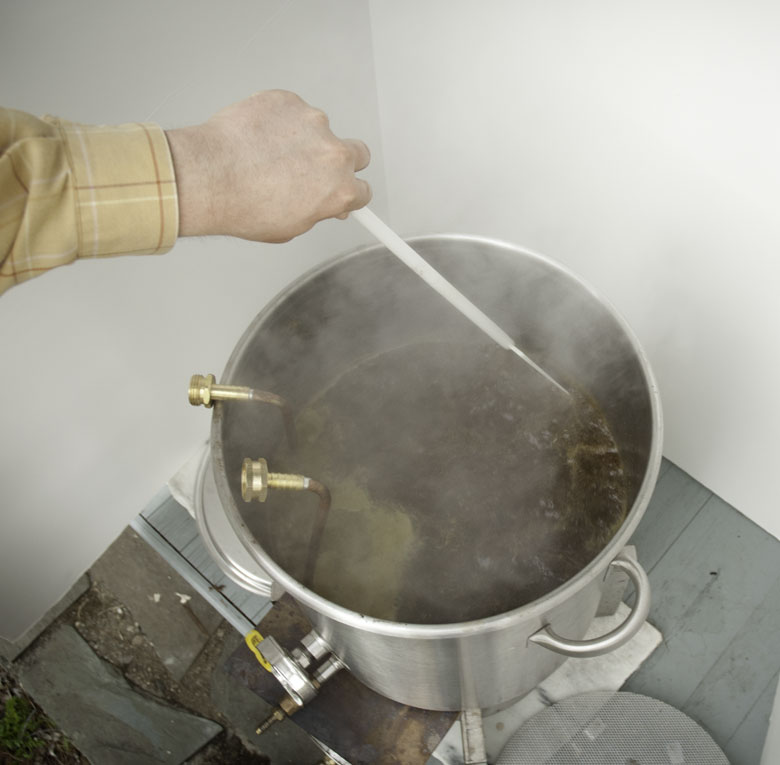Better Boils
TroubleShooting
Jonathan Connolly - Dade City, Florida asks,
I would love some discussion on the boil. A friend only boils from his first hop addition. I am a full boil guy and would never even consider cutting corners on the boil, But I do ponder the rate of boil. I love seeing that massive steam cloud with a hard boil, but suspect a softer boil is better.

As a very general rule, it takes anywhere from 60–90 minutes of boiling accompanied by 6–10% reduction in wort volume to accomplish the basic goals of wort boiling. Evaporation rate is really an indicator of the fact that the wort indeed boiled as expected and is also an indicator of how much DMS removal occurred during the boil. The removal of DMS has really become the single largest topic about boiling because DMS is such a distinctive and potentially objectionable aroma. During the boil, S-methyl methionine from malt is converted to the aromatic and volatile dimethyl sulfide. If the boil is not sufficiently vigorous, the boil wort may contain enough residual DMS to be detected in the beer. Many brewers judge the intensity of the boil by how much the surface appears to roll and the term “rolling boil” is applied to wort that is properly boiling. Since wort boiling is so energy intensive there are very real economic reasons to reduce evaporation and the obsession with DMS removal goes hand-in-hand with this pursuit. Excessive evaporation, over about 15%, is also an indicator of excess thermal stress and can lead to problems with beer foam, flavor stability and development of wort flavors undesirable to some beer styles.
New boiling technologies used by commercial brewers use a variety of clever ways of reducing DMS levels in wort while simultaneously allowing for a reduction in total volume reduction. The classical conundrum with this is that DMS is removed by evaporation, essentially steam distillation, so if kettle evaporation is reduced one would expect DMS levels to increase, and that is normally true. However, modifications to wort concentrators and spreaders in large kettles with internal calandrias enable brewers to more efficiently conduct the kettle boiling process. Thin film boilers and vacuum evaporation units have also been successfully used to tackle the same problem. In some of these systems total evaporation rates are now less than 4% with DMS levels that are less than or equal to conventional kettle designs. Side note about internal calandrias: Internal calandrias are shell and tube heat exchangers powered by steam that are installed in larger brew kettles. They resemble coffee percolators and some brewers simple call them “percs.” Calandrias normally have a chimney that directs the flow of wort and steam vapor to a spreader plate or “hat” that directs the flow of wort back into the kettle. This also helps suppress foaming in the kettle since the wort literally knocks the foam down. The thin film of wort also helps flash DMS from the wort as the steam leaves the kettle.
All of this really means very little to the homebrewer because these technologies simply do not apply to small scale boiling. The fact is that most homebrew kettles have a much higher surface area to volume ratio (calculated using the area at the top of the wort that is exposed to air) compared to larger kettles. Using the same kettle geometry (dished bottom vessel with height to diameter ratio of 0.85), I calculated the surface area to volume ratio of kettles ranging from 6 gallons (23 L) to 19,375 (73,342 L/0.2 BBL to 625 BBLs net fermenter yield) and the results are interesting. Increasing the kettle volume by a factor of five decreases the surface to volume ratio by a factor of almost two. The small kettle has 23.5 square inches per gallon and the 625 BBL kettle has only 1.4 square inches per gallon. The point with this is that small kettles have much better surface evaporation as a function of total volume than do large kettles, and one would reasonably expect homebrewers not to really understand all of the hype about DMS because this is really not a problem for beers brewed in small kettles.
The take home message is that applying commercial brewing rules to homebrewing really does not make much sense for wort boiling. Evaporation rates in small kettles are usually relatively high, often well above 10%, and I would really not worry much about this indicator. The real thing that is important is the boil time. Hop acid isomerization takes time to occur and peaks after about 60 minutes of boiling. The other goals of boiling can be achieved in far less time, especially if you are not concerned about absolute clarity in your finished beer. This is why many homebrewers are brewing great beers using short boil times. There is absolutely nothing wrong with looking for ways to improve efficiency as long as you are not sacrificing your beer quality in the process.

